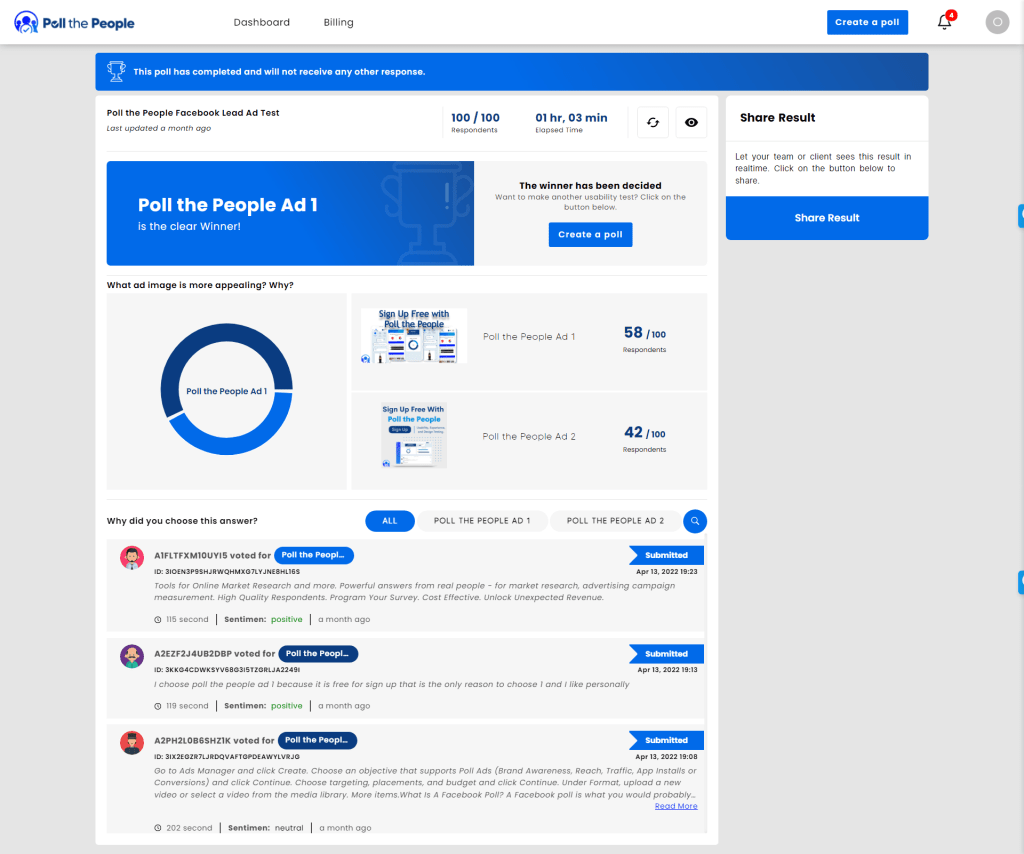
The product life cycle is the progression of stages that a product goes through throughout as it is created, beginning with development and ending with decline. It’s usually divided into six stages.
It is used by business owners and marketers to make crucial decisions and tactics about marketing budgets, product prices, and packaging.
The life cycle is active from the creation of a business or product all the way through its exit from the market. Throughout each stage, the product life cycle is used to make decisions and develop strategies.
Marketers use market research to direct their efforts as they personalize messages for each step of the product life cycle. The product life cycle helps managers make strategic decisions about pricing, market expansion, packaging design, and more.
When your product is in its early stages ad tests will be different than when they are in the maturity stage or farther along in the life cycle. For every stage, ad testing will be different. Begin ad testing when you are ready to launch your first advertisements to ensure it is optimized from the start.

What is Ad Testing?
Ad Testing is the practice of testing your ad concepts with a sample group of your market. It determines the effectiveness of an advertisement based on customer responses, feedback, and behavior. To ensure that your ads will resonate with your target audience, you can test the design of the entire ad, or parts of your ad like images or copy.
There are some tangible advantages to ad testing. According to Millward Brown, consistent pre-testing increases the impact of an ad by at least 20%. Furthermore, the content and ingenuity of an advertisement influenced earnings four times more than media placement alone.
Usability A/B testing for ads is the process of getting your ads evaluated by a target audience before you deploy them to Google, Facebook, or other distribution channels.
Allowing you to understand customers’ opinions and willingness to engage with the ads is important before you launch your campaign. There are a few ways to test your ads we’re going to focus on the most effective one; Usability A/B Testing.
Testing to measure advertising performance has the following advantages:
- You gather data to back up your decisions.
- It provides you with ways to improve your ads.
- It allows you to understand and segment diverse audiences.
- You can quickly make design changes with feedback.

Ad Testing in the Introduction Stage:
The introduction stage of a product is when it is first introduced to the market. That’s when marketing departments start raising product awareness and approaching potential customers. When a product is first presented, sales are often low, and demand grows slowly.
This phase is usually focused on marketing and advertising. Companies examine distribution channels and attempt to educate prospective customers about the product. Target customers should know what they are buying before they buy it.
Start testing your ads once your product gets introduced. At this stage everything is new, you’ll want to find broad, directional feedback on every part of your ads. Identify the messaging that resonates with users and move forward from there. Ad testing helps you to know if your marketing strategy is effective or not. With an effective marketing strategy, your product will grow.
The introduction stage of the life cycle begins when your product is released. Your marketing team’s primary goal will be to raise product awareness and reach out to your target market. All content marketing and inbound marketing are typically focused on promoting a product.
At this stage, ad testing helps in making an effective marketing strategy for a successful introduction of the product to the target audience. An introduction is the first impression of the product.

Testing in the Growth Stage:
Customers have accepted the product in the market and are beginning to genuinely buy in during the growth stage. This indicates that demand and profitability are increasing, preferably at a steady rate. In this stage of marketing, the focus shifts from attracting customer attention to establishing a brand presence. Explain why they should pick you above your competitors. As your business expands, you may want to add new features to your product, improve your customer service, and expand your distribution channels.
The growth stage occurs when the product’s market expands, and competition begins to emerge. Your success will attract potential competitors.
During this stage, marketing campaigns frequently change from gaining customer purchases to building a brand position so that consumers prefer them over new competitors. When businesses expand, they will begin to create new distribution channels and introduce additional features and support services. This will be advertised in your strategy.
At this point, you should have a good idea of the messaging for your ads. You’ll have an idea of if your ads are working or not and will want to test creativity, headlines, colors, etc. If your ads aren’t getting the results you want, revisit testing the entire ad.
At this stage, Ad testing will focus on additional features of your product. You will advertise those features and before that, you should test your ad. If the expected results are not happening, the whole ad needs to be tested.

Testing in the Maturity Stage:
The maturity stage occurs when sales start to level off after a period of rapid growth. Companies begin to lower their prices at this moment to stay competitive in the face of increasing competition.
This is the stage in which a business starts to become more effective and learns from its mistakes during the Introduction and Growth stages. Differentiation is usually prioritized over awareness in marketing campaigns. This could mean that product features are improved, prices are reduced, and distribution is increased.
Products enter the most profitable stage during maturity, production costs are decreasing while sales are increasing.
This is where most products that have been on the market for a long time are. As a result, the majority of marketing methods are designed to mature products. One technique is to release multiple versions of a fundamental product.
Your marketing activities are now focused on distinction rather than awareness, highlighting your better product characteristics. Production expenses are decreasing and sales are stable at this point. It’s easy to sit back and enjoy consistent sales, but you must continue to enhance your product and inform customers that it is improving.
Your marketing activities are now focused on intent rather than awareness, highlighting your best product features. Production expenses are decreasing, and sales are hopefully stable at this point. It’s easy to sit back and enjoy consistent sales, but you must continue to improve your product and inform customers that it is improving.
In the maturity stage of the product life cycle, you should be focusing on your ads and have clear messaging. It is best to have a good idea of what works with your ads in this stage and test a few small changes that will improve your results.
As usage grows, keep improving the product and letting customers know through your marketing strategy that the product they appreciate is better than before.
In the maturity stage, you might be testing different image concepts for your ads to display the value in the best way possible.

Testing in the Saturation Stage:
During the product saturation stage, competitors have begun taking a share of the market, and sales will neither increase nor decrease.
This is usually when the majority of customers are using a product, yet there are numerous competitors. You want your product to become the brand preference at this point to avoid entering the decline stage.
When the market is saturated, you must focus on features, brand awareness, price, and customer service uniqueness. At this point, the competition is the toughest, therefore it’s important to leave no doubt about your product’s superiority.
If product innovation isn’t possible (because the product simply requires minor modifications at this point), focus on customer service and include client testimonials in your marketing.
In the saturation stage of the product life cycle, you might have your ads so dialed in that you are only testing the color of your designs.
Many times in this stage you only make minor tweaks to your ads like the color of a button or a small part of the design. It is important to avoid major changes here as your product and ads are well defined.
Testing in the Decline Stage:
Unfortunately, if your product does not become the chosen solution in the market, you will see a drop in sales. Sales will drop as a result of the increased competition, which will be difficult to overcome.
In addition, as time passes, new trends emerge. If a company reaches this point, it will either eliminate its product, sell the business, or innovate and improve to stay relevant.
While businesses would like to prevent the decline stage, it is often unavoidable — especially if the overall market, not just your product, is in decline. To successfully exit this stage, you can use nostalgia or emphasize the superiority of your solution in your marketing strategy.
Successful organizations can also apply new advertising methods, reduce pricing, and add new features to boost their value proposition, launch an affiliate campaign, explore new markets, or modify brand packaging to stretch the product life cycle.
Testing ads in the decline stage of your product is important, if you reach this stage, you might be in need of a rebrand or changes to your ads to improve sales, engagement, or leads.
Consider testing brand-new designs for your ads to find ways to build the product once again and get more out of your ads.
Conclusion
Testing ads throughout the product life cycle is a great way to continuously optimize your digital marketing and is a part of an agile market research method. It offers a manageable process for running tests and allows your team to make great decisions moving forward.
How a product is marketed to consumers changes as the product advances through the product life cycle. When a product is successfully introduced to the market, it needs to experience an increase in demand and popularity, displacing older items.
Failure to manage the stages of the life cycle might result in a product failing to achieve the business goals and reduced shelf life.
Pre-testing ad concepts can help you get your campaign off to a good start and avoid costly blunders. In-flight campaign monitoring allows you to track a campaign’s performance throughout its lifecycle, allowing you to pinpoint conversions and see how sentiment and purchase decisions change over time in response to your ad. Working with a pre-selected segment of your audience that represents the campaign’s target group is the best way to test an ad concept.
As you begin to put together your testing process, you’ll find exactly what works for your business. Now that you have all this information you can sign up and start testing with Poll the People today.
- How To Retain SEO Ranking After A Redesign - February 22, 2023
- Ultimate Guide: How to Write Brand Names - February 17, 2023
- 10 Best Practices for Using Video in Your Email Marketing Campaigns - February 8, 2023




